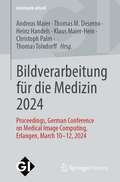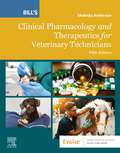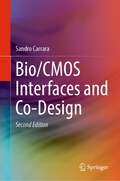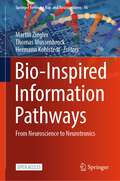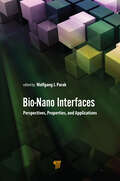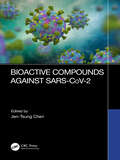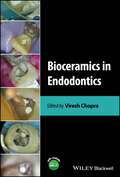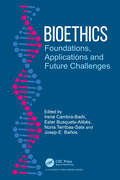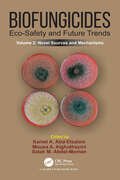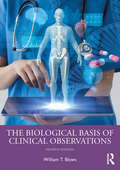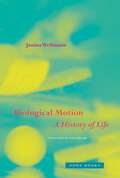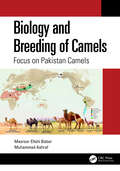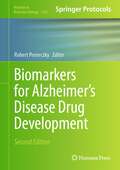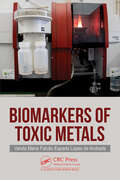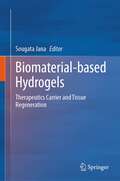- Table View
- List View
Bildverarbeitung für die Medizin 2024: Proceedings, German Conference on Medical Image Computing, Erlangen, March 10-12, 2024 (Informatik aktuell)
Seit mehr als 25 Jahren ist der Workshop "Bildverarbeitung für die Medizin" als erfolgreiche Veranstaltung etabliert. Ziel ist auch 2024 wieder die Darstellung aktueller Forschungsergebnisse und die Vertiefung der Gespräche zwischen Wissenschaftlern, Industrie und Anwendern. Die Beiträge dieses Bandes - viele davon in englischer Sprache - umfassen alle Bereiche der medizinischen Bildverarbeitung, insbesondere die Bildgebung und -akquisition, Segmentierung und Analyse, Visualisierung und Animation, computerunterstützte Diagnose sowie bildgestützte Therapieplanung und Therapie. Hierbei kommen Methoden des maschinelles Lernens, der biomechanischen Modellierung sowie der Validierung und Qualitätssicherung zum Einsatz.
Bill's Clinical Pharmacology and Therapeutics for Veterinary Technicians - E-Book: Bill's Clinical Pharmacology and Therapeutics for Veterinary Technicians - E-Book
by Melinda AndersonBuild the skills you need to use drugs safely and avoid potential problems! Trusted by vet techs for 30 years, Bill's Clinical Pharmacology and Therapeutics for Veterinary Technicians helps you understand the principles and practice of pharmacology in treating different animal species. The text explains how drugs work, how they are administered, and how to calculate drug dosages. Covering drugs by body system, the book also explains possible abuses, mistakes, and how things can go wrong when therapeutic protocols are not properly implemented. From veterinary pharmacist and educator Melinda "Mindy" Anderson, this fifth edition helps you provide better care for your patients and better education for their owners. Content on basic pharmacology includes topics such as safety, terminology, pharmacy procedures, drug handling (including the latest OSHA requirements), dosage calculations, and pharmacokinetics. Chapter outlines, learning objectives, and key terms are provided at the beginning of each chapter, introducing you to the complex principles of pharmacology and guiding your study. Clear explanations of drugs help you understand the "how" and "why" behind drugs, their actions, their mechanisms, and adverse effects. Myths and Misconceptions, Ask Dr. Bill, and You Need to Know boxes spotlight key issues, concepts, and skills. Clinical applications link pharmacologic concepts to real-life situations. Review questions and critical thinking questions are included at the end of every chapter to help readers test their comprehension. Test questions and online quizzes enable self-assessment and help you prepare for classroom and certification exams. NEW Veterinary Feed Directives section reflects the newest FDA guidelines on medicated feed for animals. NEW! Updated drug information includes all drug categories as well as new information on several drugs. NEW! Additional full-color images make it easier to understand pharmacology concepts. NEW! Updated test questions and drug calculation exercises on the Evolve website make study and review easier and reinforce your understanding of difficult subject matter.
Bio/CMOS Interfaces and Co-Design
by Sandro CarraraThis textbook demonstrates new paradigms for the interface between CMOS circuits and the biological world. A deep theoretical description of such an interface is defined and discussed, while various real applications are demonstrated by also discussing several analog CMOS circuits. Electrochemical techniques are proposed in detail to learn how to design integrated biosensors. Biological materials are described to provide devices selectivity. Nanoscale materials are discussed to provide device sensitivity. CMOS circuits are analyzed to provide real applications. Extensive examples with solutions are provided, as well as exercises at the end of each chapter. This book introduces students to the state-of-the-art in Bio/CMOS interfaces, describing leading-edge research in CMOS design and VLSI development for applications requiring intimate integration of biological molecules onto the chip. It provides multidisciplinary content ranging from biochemistry to CMOS design in order to address Bio/CMOS interface co-design in biosensing applications.
Bio-Inspired Information Pathways: From Neuroscience to Neurotronics (Springer Series on Bio- and Neurosystems #16)
by Martin Ziegler Thomas Mussenbrock Hermann KohlstedtThis open access book offers a timely and comprehensive review of the field of neurotronics. Gathering cutting-edge contributions from neuroscientists, biologists, psychologists, as well as physicists, microelectronics engineers and information scientists, it gives extensive information on fundamental information pathways in selected nervous systems. It also highlights their relevance as building blocks for novel computing architectures, such as bio-inspired electronic devices, neuromorphic architectures, memristive devices, adaptive sensors and emergent, pulsed-coupled oscillatory networks. All in all, this book offers a unique bridge between fundamental research in neuroscience, neural information processing, nonlinear dynamics, and self-organization, and advanced practical applications concerning the fabrication of hardware-oriented computing.
Bio-Nano Interfaces: Perspectives, Properties, and Applications
by Wolfgang ParakIn recent decades, bio-nano interfaces have become a popular topic of research. The interface between biology (e.g., cells, proteins) and man-made materials (e.g., surfaces of labware, medical devices/implants, etc., that are exposed to the biological matter) has always been important, way before the terms of nanotechnology and nanoscience were coined. Nanotechnology brought new techniques into play, with which such interfaces can be investigated with an additional viewpoint. This book is a collection of articles spanning two decades that shows how the newer publications have evolved from the older ones. This allows the reader to see the development in the field not only technically but also conceptually. The book is, in particular, suitable for the researchers and general readers who are looking for inspiration on how ideas develop over decades.
Bio-Nano Interfaces: Perspectives, Properties, and Applications
by Wolfgang J. ParakIn recent decades, bio-nano interfaces have become a popular topic of research. The interface between biology (e.g., cells, proteins) and man-made materials (e.g., surfaces of labware, medical devices/implants, etc., that are exposed to the biological matter) has always been important, way before the terms of nanotechnology and nanoscience were coined. Nanotechnology brought new techniques into play, with which such interfaces can be investigated with an additional viewpoint. This book is a collection of articles spanning two decades that shows how the newer publications have evolved from the older ones. This allows the reader to see the development in the field not only technically but also conceptually. The book is, in particular, suitable for the researchers and general readers who are looking for inspiration on how ideas develop over decades.
Bioactive Compounds Against SARS-CoV-2
by Jen-Tsung ChenCoronaviruses can cause illness, severe disease, and death; for example, Middle East respiratory syndrome (MERS), severe acute respiratory syndrome (SARS), and COVID-19. Vaccine development and antiviral drugs are challenged by the propensity for viral mutations allowing these viruses to evade such therapies. There are a number of bioactive compounds from natural sources, which can exert health benefits and act as antiviral therapies such as anti-inflammation, antioxidative stress, and immune regulation. This book summarizes research on the potential efficacy and underlying mechanisms of bioactive compounds and traditional medicines against SARS-CoV-2. Key Features Summarizes the potential benefits of bioactive therapies for coronaviruses Focuses on COVID-19, but also covers MERS and SARS Provides alternatives to vaccines and other antiviral drugs whose efficacy is reduced by viral mutations Relevant for clinicians and public health officials
Bioactive Compounds Against SARS-CoV-2
by Jen-Tsung ChenCoronaviruses can cause illness, severe disease, and death; for example, Middle East respiratory syndrome (MERS), severe acute respiratory syndrome (SARS), and COVID-19. Vaccine development and antiviral drugs are challenged by the propensity for viral mutations allowing these viruses to evade such therapies. There are a number of bioactive compounds from natural sources, which can exert health benefits and act as antiviral therapies such as anti-inflammation, antioxidative stress, and immune regulation. This book summarizes research on the potential efficacy and underlying mechanisms of bioactive compounds and traditional medicines against SARS-CoV-2. Key Features Summarizes the potential benefits of bioactive therapies for coronaviruses Focuses on COVID-19, but also covers MERS and SARS Provides alternatives to vaccines and other antiviral drugs whose efficacy is reduced by viral mutations Relevant for clinicians and public health officials
Bioceramics in Endodontics
by Viresh ChopraBioceramics in Endodontics Practical reference book in the emerging field of endodontics, focusing on overall makeup of dental bioceramics and relevant clinical situations in endodontics where various forms of bioceramics has been used to treat teeth successfully. Bioceramics in Endodontics is a highly unique resource that blends together detailed information on the physico-chemical and biological properties of bioceramics with their clinical application in endodontics, exploring history and chemistry, mechanical properties, advantages of bioceramics over other materials, and clinical cases with high definition pictures and videos demonstrating their usage across wide variety of clinical situations in endodontics. Written by highly qualified authors with significant experience in the field, Bioceramics in Endodontics includes information on: Material characteristics of bioceramics that Endodontists/Clinicians should be aware of Evidence based decisions between coneless and coned obturations, and healing of periapical lesions over a recall period of 3-5 years Endodontic treatment of patients using bioceramic sealers Endodontic mishaps treated with bioceramic repair material Evidence based approach for apexification using bioceramics Use of bioceramics as a root end filling material and guidelines guidelines to finding new applications for bioceramics Comparison of Bioceramics with gold standard endodontic materials A highly unique exploration into the subject, Bioceramics in Endodontics provides an essential core overview of the field of bioceramics in endodontics and related applications, making it a must-have resource for dental practitioners, along with undergraduate and postgraduate students in endodontics and other related programs of study.
Bioceramics in Endodontics
by Viresh ChopraBioceramics in Endodontics Practical reference book in the emerging field of endodontics, focusing on overall makeup of dental bioceramics and relevant clinical situations in endodontics where various forms of bioceramics has been used to treat teeth successfully. Bioceramics in Endodontics is a highly unique resource that blends together detailed information on the physico-chemical and biological properties of bioceramics with their clinical application in endodontics, exploring history and chemistry, mechanical properties, advantages of bioceramics over other materials, and clinical cases with high definition pictures and videos demonstrating their usage across wide variety of clinical situations in endodontics. Written by highly qualified authors with significant experience in the field, Bioceramics in Endodontics includes information on: Material characteristics of bioceramics that Endodontists/Clinicians should be aware of Evidence based decisions between coneless and coned obturations, and healing of periapical lesions over a recall period of 3-5 years Endodontic treatment of patients using bioceramic sealers Endodontic mishaps treated with bioceramic repair material Evidence based approach for apexification using bioceramics Use of bioceramics as a root end filling material and guidelines guidelines to finding new applications for bioceramics Comparison of Bioceramics with gold standard endodontic materials A highly unique exploration into the subject, Bioceramics in Endodontics provides an essential core overview of the field of bioceramics in endodontics and related applications, making it a must-have resource for dental practitioners, along with undergraduate and postgraduate students in endodontics and other related programs of study.
Bioethics: Foundations, Applications and Future Challenges
by Irene Cambra-Badii Ester Busquets-Alibés Terribas-Sala Núria Josep-E. BañosThe aim of this book is to introduce and discuss bioethics in a three-synergistic way: from the foundations to the current debates in relation to healthcare and social bioethics, and thereafter the possible future challenges. In this sense, the target audience can be from diverse disciplines: life and medical sciences, law, philosophy, psychology, and education. The book will be useful to high school students, in their first contacts with bioethics, college students, teachers and researchers, and the general public interested in these controversial debates of the past, present and future of bioethics.
Bioethics: Foundations, Applications and Future Challenges
The aim of this book is to introduce and discuss bioethics in a three-synergistic way: from the foundations to the current debates in relation to healthcare and social bioethics, and thereafter the possible future challenges. In this sense, the target audience can be from diverse disciplines: life and medical sciences, law, philosophy, psychology, and education. The book will be useful to high school students, in their first contacts with bioethics, college students, teachers and researchers, and the general public interested in these controversial debates of the past, present and future of bioethics.
Biofungicides: Novel Sources and Mechanisms, Volume 2
The current volume focuses on novel sources of biofungicides, primarily providing complete knowledge of microbial and phytochemical fungicides, studying antifungal activity mechanisms as well as their role in disease management in plants, and fungicide bioremediation. The use of biofungicides as eco-friendly alternative to typical synthetic fungicides is projected to play a significant role in organic farming in the future.Key Features: Discovers novel sources of biofungicides Describes the role of biofungicides in the control of plant diseases Studies antifungal activity mechanisms Explores how to survey and select promising biofungicides
Biofungicides: Novel Sources and Mechanisms, Volume 2
by Kamel A. Abd-Elsalam Mousa A. Alghuthaymi Salah M. Abdel-MomenThe current volume focuses on novel sources of biofungicides, primarily providing complete knowledge of microbial and phytochemical fungicides, studying antifungal activity mechanisms as well as their role in disease management in plants, and fungicide bioremediation. The use of biofungicides as eco-friendly alternative to typical synthetic fungicides is projected to play a significant role in organic farming in the future.Key Features: Discovers novel sources of biofungicides Describes the role of biofungicides in the control of plant diseases Studies antifungal activity mechanisms Explores how to survey and select promising biofungicides
The Biological Basis of Clinical Observations
by William T. BlowsFully updated for its fourth edition, The Biological Basis of Clinical Observations provides readers with the understanding needed to perform clinical observations, make accurate judgements about the patient’s condition and make good decisions concerning patient care. This essential textbook supports safe and effective clinical practice by explaining the techniques involved in making clinical observations, alongside the biological knowledge which gives them meaning. For each topic, it explains the pathological basis for variations in observed results, focusing on relevant anatomy and physiology, genetics and pharmacology, and the basic principles of care. A greatly expanded chapter on pharmacology reflects the increased importance of this subject in the nursing curriculum. Topics discussed include: temperature cardiovascular observations respiratory observations urinary and bowel observations neurological observations • nutrition fluid balance skin pharmacology pregnancy. The Biological Basis of Clinical Observations is a unique text which integrates explanations of essential procedures with the biological knowledge that underpins practice. It is essential reading for all nursing and healthcare students preparing for clinical practice.
The Biological Basis of Clinical Observations
by William T. BlowsFully updated for its fourth edition, The Biological Basis of Clinical Observations provides readers with the understanding needed to perform clinical observations, make accurate judgements about the patient’s condition and make good decisions concerning patient care. This essential textbook supports safe and effective clinical practice by explaining the techniques involved in making clinical observations, alongside the biological knowledge which gives them meaning. For each topic, it explains the pathological basis for variations in observed results, focusing on relevant anatomy and physiology, genetics and pharmacology, and the basic principles of care. A greatly expanded chapter on pharmacology reflects the increased importance of this subject in the nursing curriculum. Topics discussed include: temperature cardiovascular observations respiratory observations urinary and bowel observations neurological observations • nutrition fluid balance skin pharmacology pregnancy. The Biological Basis of Clinical Observations is a unique text which integrates explanations of essential procedures with the biological knowledge that underpins practice. It is essential reading for all nursing and healthcare students preparing for clinical practice.
Biological Motion: A History of Life
by Janina WellmannA captivating exploration of the changing definitions of life in biologyBiological Motion studies the foundational relationship between motion and life. To answer the question, &“What is Life?,&” prize-winning historian of science Janina Wellmann engages in a transdisciplinary investigation of motion as the most profound definition of living existence.For decades, information and structure have dominated the historiography of the life sciences with its prevailing focus on DNA structure and function. Now more than ever, motion is a crucial theme of basic biological research. Tracing motion from Aristotle&’s animal soul to molecular motors, and from medical soft robotics to mathematical analysis, Wellmann locates biological motion at the intersection of knowledge domains and scientific and cultural practices. She offers signposts to mark the sites where researchers, technologies, ideas, and practices opened up new paths in the constitution of the phenomenon of motion. An ambitious rethinking of the life sciences, Biological Motion uncovers the secret life of movement and offers a new account of what it means to be alive.
Biological Motion: A History of Life
by Janina WellmannA captivating exploration of the changing definitions of life in biologyBiological Motion studies the foundational relationship between motion and life. To answer the question, &“What is Life?,&” prize-winning historian of science Janina Wellmann engages in a transdisciplinary investigation of motion as the most profound definition of living existence.For decades, information and structure have dominated the historiography of the life sciences with its prevailing focus on DNA structure and function. Now more than ever, motion is a crucial theme of basic biological research. Tracing motion from Aristotle&’s animal soul to molecular motors, and from medical soft robotics to mathematical analysis, Wellmann locates biological motion at the intersection of knowledge domains and scientific and cultural practices. She offers signposts to mark the sites where researchers, technologies, ideas, and practices opened up new paths in the constitution of the phenomenon of motion. An ambitious rethinking of the life sciences, Biological Motion uncovers the secret life of movement and offers a new account of what it means to be alive.
Biology and Breeding of Camels: Focus on Pakistan Camels
by Masroor Ellahi Babar Muhammad AshrafThis book discusses the biology, breeding, care, and management of camels, with a focus on camels from Pakistan. The book provides a sound understanding of how to look after camels, their senses, behavior, and adaptations. The chapters describe the practical aspects of camel husbandry such as how to maintain their body condition, feet, and cleanliness. It covers the types of feeds, feeding methods, and their needs at different stages of life. The book provides a detailed account of camel husbandry, breeding, and reproduction. It is meant for camel breeders, veterinarians, livestock advisers, students, and researchers working on animal sciences, camel rearing, feeding, and management.FEATURES Includes information about different species of camels present in Pakistan and their importance to humans Discusses the nutrition and feeding of camels, the medicinal qualities of camel milk, and the peculiar immunity-enhancing properties of their nutritious meat Describes the features of camels that help them survive and thrive in deserts and make them the animals of the future Covers the range of unique products obtained from camels and their economic value Explores the management, types of diseases in camels, causes of their spread, their control, and therapeutic measures for successful and productive farming
Biology and Breeding of Camels: Focus on Pakistan Camels
by Masroor Ellahi Babar Muhammad AshrafThis book discusses the biology, breeding, care, and management of camels, with a focus on camels from Pakistan. The book provides a sound understanding of how to look after camels, their senses, behavior, and adaptations. The chapters describe the practical aspects of camel husbandry such as how to maintain their body condition, feet, and cleanliness. It covers the types of feeds, feeding methods, and their needs at different stages of life. The book provides a detailed account of camel husbandry, breeding, and reproduction. It is meant for camel breeders, veterinarians, livestock advisers, students, and researchers working on animal sciences, camel rearing, feeding, and management.FEATURES Includes information about different species of camels present in Pakistan and their importance to humans Discusses the nutrition and feeding of camels, the medicinal qualities of camel milk, and the peculiar immunity-enhancing properties of their nutritious meat Describes the features of camels that help them survive and thrive in deserts and make them the animals of the future Covers the range of unique products obtained from camels and their economic value Explores the management, types of diseases in camels, causes of their spread, their control, and therapeutic measures for successful and productive farming
Biomarkers for Alzheimer’s Disease Drug Development (Methods In Molecular Biology Ser. #1750)
by Robert PerneczkyBiomarkers for Alzheimer’s Disease Drug Development (Methods in Molecular Biology #2785)
by Robert PerneczkyThis fully updated volume provides an up-to-date and comprehensive overview of the current state of technologies helping to accelerate Alzheimer’s disease drug development. Addressing the latest advances in preclinical and clinical research, including new insights into the molecular mechanisms and emerging therapeutic strategies, the book continues by exploring digital biomarkers and advanced neuroimaging analysis which will transform how clinical trials in the Alzheimer’s disease field are performed. Written for the highly successful Methods in Molecular Biology series, chapters feature the kind of detailed implementation advice that leads to greater success in the lab or clinic. Authoritative and practical, Biomarkers for Alzheimer’s Disease Drug Development, Second Edition seeks to inspire and inform future efforts to develop effective treatments for this devastating disease.
Biomarkers of Toxic Metals
by Vanda Maria Lopes de AndradeThe current exposure of human populations to toxic metals makes the prevention and control of such exposures crucial. Biomarkers are undoubtably recognized as vital tools to achieve these goals. This book is for researchers, toxicologists, physicians, pharmacologists and those working in governmental regulatory agencies and other public health fields. The first part of this book covers general aspects of biomarkers of toxic metals, while parts 2 and 3 cover biomarkers of xenobiotic metals and essential metals with potential for toxicity, respectively. In part 4, novel approaches to metal biomarkers are focused.
Biomarkers of Toxic Metals
by Vanda Maria Lopes de AndradeThe current exposure of human populations to toxic metals makes the prevention and control of such exposures crucial. Biomarkers are undoubtably recognized as vital tools to achieve these goals. This book is for researchers, toxicologists, physicians, pharmacologists and those working in governmental regulatory agencies and other public health fields. The first part of this book covers general aspects of biomarkers of toxic metals, while parts 2 and 3 cover biomarkers of xenobiotic metals and essential metals with potential for toxicity, respectively. In part 4, novel approaches to metal biomarkers are focused.
Biomaterial-based Hydrogels: Therapeutics Carrier and Tissue Regeneration
by Sougata JanaThis book highlights recent advances in natural and synthetic biomaterials-based hydrogel for drug delivery carriers and tissue engineering. It covers key topics such as chitosan, alginate, gelatin, cyclodextrin, cellulose, starch, hyaluronic acid, dextran, collagen hydrogel, Injectable hydrogel magnetic hydrogel, DNA-based hydrogels, 3D printing of hydrogels, hydrogel for bone tissue engineering and regenerative medicine, etc. Each chapter develops a particular aspect of recent advances in biomaterial-based Hydrogels delivery systems to cover the importance, fabrication technology, characterization, evaluation, delivery of therapeutic and biomedical applications, and future perspectives. Written by a group of renowned scientists, chemists, biologists, and engineers from around the world, the book is designed as an important reference resource for scientists and researchers working on advanced biomaterials in the fields of pharmaceuticals, biomedical science, biomedical engineering,nanotechnology, and material science for most updated findings and future research trends.
